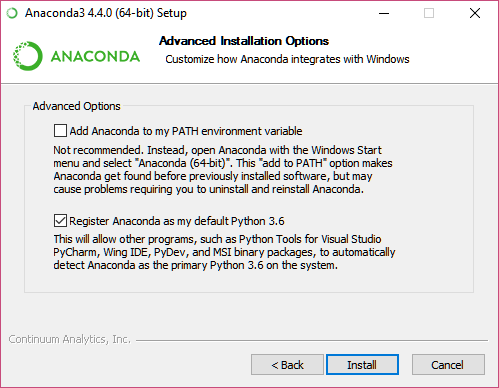Virtual Environments. Examples of instructions for installing a requirements.txt file are typically preceded by a source bin/activate command which executes the activate script in the project’s bin folder. An activate script is placed in each virtual environment established to store different sets of dependencies required by different projects in separate isolated locaations.
This post introduces how to install Miniconda on CentOS 7 / RedHat 7.
- Download the graphical macOS installer for your version of Python. RECOMMENDED: Verify data integrity with SHA-256. For more information on hashes, see What about cryptographic hash verification? Double-click the downloaded file and click continue to start the installation. Answer the prompts on the Introduction, Read Me, and License screens.
- SHA-256 checksums are available for Miniconda and Anaconda. We do not recommend using MD5 verification as SHA-256 is more secure. Download the installer file and before installing verify it as follows: Windows: If you have PowerShell V4 or later: Open a.
- Installing Miniconda Mac. Follow the below instructions to install the latest Miniconda version for Mac. Go to the Miniconda Download page and download the Python 3.7 Mac OS X 64-bit.pkg installer. After the download is complete, run the installer and click through the setup steps leaving all the pre-selected installation defaults.
(Tested on CentOS 7 / RedHat 7, but it should work for Ubuntu OS as well. Note that you can install Miniconda / Anaconda onto your Linux OS even when you are not a sudo / root user.)
(For installing Miniconda on Mac, check out this post.)
(For commonly used conda commands check this post.)
(For the comparison among Anaconda, Miniconda, and Virtualenv with pip, checkthis post.)
Step 1: Open a Terminal window, type

Step2: Run the following bash script to install it
Step3: To make the changes take effect, close the terminal and open a new Terminal window.
Step 4: Test conda
In the newly open Terminal window, type the following
Step 5: Uninstalling Miniconda
To uninstall Python Anconda/Miniconda, we just simply remove the installation folder and remove the environment variables set in .bashrc file. For my installation, it will be just like this.
Then, you can edit the ~/.bashrc file and remove the following entries added for Anaconda/Miniconda directory from your PATH environment variable
How To Uninstall Miniconda
For commonly used conda commands check this post.
For the comparison among Anaconda, Miniconda, and Virtualenv with pip, checkthis post.
References:
The default Anaconda installation option is “Just Me”, whichgives an independent installation of Anaconda that will notbe shared with other users on the same system.The other option is to install for all users.
All users¶
If you have administrator access, you can choose toinstall for “All Users”. This is a good option for a multi-usersystem where you want to allow users to import Python librariesand run Python applications.
This option does not give write permissions by default sothe users will not be able to install packages in the rootenvironment. It allows an administrator to protect what isin the root environment. If packages are needed in the rootenvironment, you can elevate the privileges to administratorfrom the Command Prompt and run install commands.
Multi-user Anaconda installation on Windows¶
- Download the Anaconda installer.
- Double click the installer to launch.
- Click Next to continue.
- Read the licensing terms and click “I Agree”.
- Select an install for “All Users” (this requires administrator privileges on the computer) and click Next.
- Click “Yes” to allow the installer to make changes to your computer.
- Select a destination folder that is accessible to the users, the default is
C:ProgramDataAnaconda. - After your install is complete, open Computer Management, navigate to Local Users and Groups. Create a new group for your Anaconda users. Add users to this new group, Anaconda-Users.
- Navigate to your Anaconda directory and then go to the Properties. Uncheck the box for Attrributes: Read-only and save changes. Go to the Security tab and click Edit. From there you can add Anaconda-Users and set permissions. Your group will need read and write privileges.
Multi-user Anaconda installation on Linux¶

Install Miniconda
To set up a multi-user Anaconda or Miniconda installation on Linux operating systems:
Linux Miniconda
- Install Anaconda.
- After installation is complete, create a new group:
sudogroupaddmygroup - Change the group ownership to “mygroup” on the entiredirectory where Anaconda is installed:
sudochgrp-Rmygroup/opt/anaconda2.Replace/opt/anaconda2with the actual path to your installed Anaconda file. - Set read and write permission for the owner, root, and the mygroup only:
sudochmod770-R/opt/anaconda2 - Add users to a group:
sudoadduserusernamemygroup.Users added to the “mygroup” group now have the abilityto access Anaconda, install packages, and create environments.
This is another option for all-user installation.It installs Anaconda at C:Anaconda, which is not a protecteddirectory and can have write permissions set for users.This is a good option if your username has spaces in itbecause the Anaconda installer cannot install in paths thatcontain spaces.